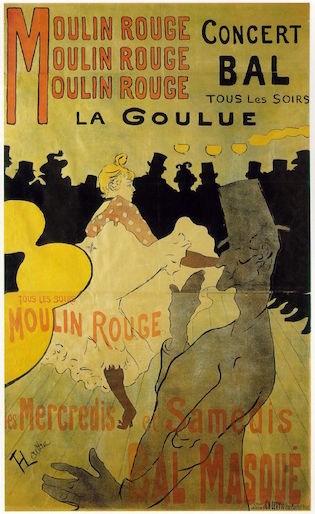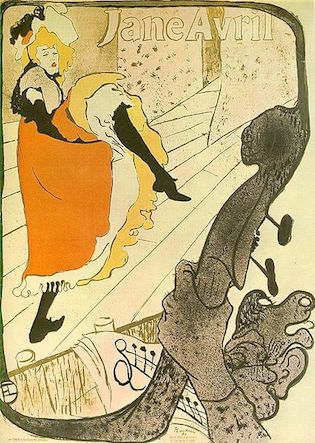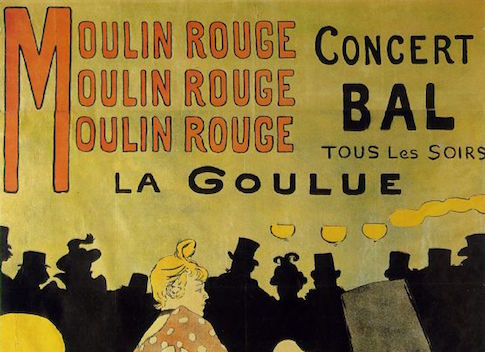Toulouse-Lautrec Illustrates the Belle Époch opens at the Phillips Collection Saturday, presenting for the first time in the United States a rare collection of ninety-six prints and posters from the artist's lithographic period, along with five works by his contemporaries. This exhibition is the first collaboration between the Phillips and the Montreal Museum of Fine Arts, and allows its patrons a glimpse at the lively nightlife of the turn of the century and the celebrated figures who enjoyed it, and a look at the peak convergence of art and advertising in the posters that lined the streets of Paris.
The ostensible purpose for a poster in the Belle Époch was to advertise and decorate, but for Henri de Toulouse-Lautrec (1864-1901) it was a new medium to record a fleeting moment. The lithograph made creating prints easier, and Toulouse-Lautrec revolutionized the medium by adding spatter for tonal hues, purposefully omitting or saturating color, cropping figures, and using a dramatic scale, sometimes creating pieces taller than himself (he was 5’1). He chose subject matter that broke social conventions—prostitutes, mixed social classes, the lesbian community, and bar-goers—perhaps because he empathized with those who felt different, despite his own privileged background.
Toulouse-Lautrec was born into an aristocratic family in the medieval town Albi in the south of France. The family’s history extended back to the Crusades, and they kept their fortune intact by marrying within the family. Toulouse-Lautrec’s parents were first cousins, which led to a genetic disorder that stunted the growth of his legs and caused numerous physical and mental health problems. Moving to Paris’s bohemian Montmartre district in 1882, he trained with academic artists and fell into a circle of avant-garde contemporaries: Louis Anquetin, Vincent van Gogh, Pierre Bonnard, Edouard Vuillard. One can view selected pieces by his contemporaries in this exhibition, including an Anquetin painting never shown before in the United States.

The exhibition is hung in a loose chronology, beginning with Toulouse-Lautrec’s first iconic, massive poster, Moulin Rouge, La Goulue (1891) beside its trial proof. Toulouse-Lautrec won a Moulin Rouge poster competition with the 5.5’x4.5’, three-layer print featuring the rapacious La Goulue, a provocative dancer who was notorious for knocking mens’ top hats off with high kicks during her dances, often performed without undergarments. This poster, the first to feature a star attraction, was a particular success, and 3,000 impressions were made.
While posters at the time tended to be limited to three colors, Toulouse-Lautrec used four, and later used up to seven or eight colors. In Moulin Rouge, La Goulue one can see the beginnings of his spatter technique to create the tonal hues in the silhouette of Goulue’s dance partner. He makes Goulue easily recognizable, crafting her face and signature chignon with deliberate strokes reminiscent of Honoré Daumier, while leaving her skirt white. Toulouse-Lautrec maintains an engaging composition by simultaneously cropping and framing Goulue with simple, bright yellow gaslights, who stands out all the more from the silhouette of the audience behind her.
By compressing the figure of Goulue with the gaslights, the audience, and her dance partner, Toulouse-Lautrec succeeds in making her the focal point and creates a realistic vantage. He uses this technique of involving the spectator in an intimate moment throughout the collection. One sees it applied in the poster The Englishman at the Moulin Rouge (1892), a brush and spatter lithograph featuring six or seven colors on two sheets.
Toulouse-Lautrec marks the English artist William Warrener as an outsider by saturating his figure with maroon. The Englishman leans in towards two women, the Moulin Rouge dancers Rayon d’Or and La Sauterelle, and the moment is a nod to the prostitution that was common at the Montmartre hotspot. The lithograph went through a black and white and color state, with 100 impressions printed of each, and was also made into an oil on cardboard painting that can be seen at the Metropolitan Museum of Art.
He continued to promote celebrities of Montmartre nightlife in commissions he received from other Parisian clubs. The poster Ambassadeurs, Aristide Bruant (1892) featured his friend, the singer Aristide Bruant, who sang about the living conditions of Paris’s poor and pulled an audience of all social classes.

But Toulouse-Lautrec’s most frequent model is the singer-dancer Jane Avril. He created posters to promote her shows, or simply used her as a model. The second-to-last poster Toulouse-Lautrec made was commissioned by Avril. It was never circulated when he made it, but it is one of his most iconic, and the exhibit presents the rare opportunity to view it next to a trial proof. Jane Avril (1899), portrays the singer in a black dress and bright red hat, leaning to her right with her hands raised as a yellow and blue snake wraps around her body. This is one of Toulouse-Lautrec’s many pieces in which he most likely worked from a photograph, and its flat color and contoured lines enforce how inspired he was by Japanese art.
While the advertisement posters still reveal Toulouse-Lautrec’s eye for impressive, unique composition, and storytelling, perhaps his most fascinating lithographs are those of the Elles portfolio (1893-1896), that feature the women of brothels the artist frequented, and the lesbian community that fascinated him. The cover of the portfolio—Elles (1896)—portrays a woman in her dressing gown seen from behind, and the only reference to her profession is a top hat sitting on a bed strewn with clothes. Woman Fastening a Corset, Passing Conquest (1896) captures a woman dressing or undressing, while a man in a top hat looks on. For Woman Lying on Her Back, Lassitude (1896), Toulouse-Lautrec uses an alizarin crayon, reminiscent of a 15th century drawing.
But the most intriguing and iconic lithograph of the portfolio is the 1896 portrait of the Moulin Rouge’s female acrobat and clown Cha-U-Kao. She looks weary, with her legs splayed while she leans forward and gazes towards the viewer, as if she is sharing an intimate moment or secret. The exhibit presents familiar, iconic lithographs that make up about 30 percent of Toulouse-Lautrec’s corpus. Most are advertisements, while others were for popular poster portfolios, such as the portfolio of first edition crayon lithographs for the performer Yvette Guilbert.
The French art critic André Mellerio wrote, "If M. de Toulouse-Lautrec’s art is not uplifting in terms of virtue overcoming vice, at least he has analyzed vice with a highly unusual degree of perceptiveness; he has mastered the science of particular behaviors, which he had dressed in the garb of our epoch, known as the turn-of-the-century." Walking through the exhibit reveals a story: Subjects of the posters become familiar faces that inspire all the more intrigue; the act of drinking absinthe next to Emile Bernard in a smoke filled room becomes a reality frozen in time. By the end, the patron will see how the artists of the Belle Époque established a style that continues to present day, using popular media to advertise the frivolity of dance, song, theater, and celebrity.
